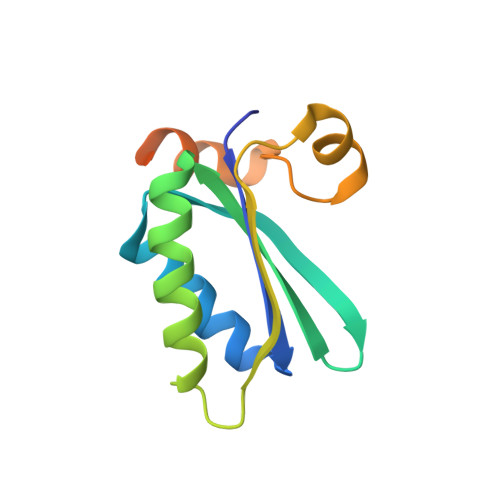Heterohexamers Formed by CcmK3 and CcmK4 Increase the Complexity of Beta Carboxysome Shells.
Sommer, M., Sutter, M., Gupta, S., Kirst, H., Turmo, A., Lechno-Yossef, S., Burton, R.L., Saechao, C., Sloan, N.B., Cheng, X., Chan, L.G., Petzold, C.J., Fuentes-Cabrera, M., Ralston, C.Y., Kerfeld, C.A.(2019) Plant Physiol 179: 156-167
- PubMed: 30389783
- DOI: https://doi.org/10.1104/pp.18.01190
- Primary Citation of Related Structures:
5VGU - PubMed Abstract:
Bacterial microcompartments (BMCs) encapsulate enzymes within a selectively permeable, proteinaceous shell. Carboxysomes are BMCs containing ribulose-1,5-bisphosphate carboxylase oxygenase and carbonic anhydrase that enhance carbon dioxide fixation. The carboxysome shell consists of three structurally characterized protein types, each named after the oligomer they form: BMC-H (hexamer), BMC-P (pentamer), and BMC-T (trimer). These three protein types form cyclic homooligomers with pores at the center of symmetry that enable metabolite transport across the shell. Carboxysome shells contain multiple BMC-H paralogs, each with distinctly conserved residues surrounding the pore, which are assumed to be associated with specific metabolites. We studied the regulation of β-carboxysome shell composition by investigating the BMC-H genes ccmK3 and ccmK4 situated in a locus remote from other carboxysome genes. We made single and double deletion mutants of ccmK3 and ccmK4 in Synechococcus elongatus PCC7942 and show that, unlike CcmK3, CcmK4 is necessary for optimal growth. In contrast to other CcmK proteins, CcmK3 does not form homohexamers; instead CcmK3 forms heterohexamers with CcmK4 with a 1:2 stoichiometry. The CcmK3-CcmK4 heterohexamers form stacked dodecamers in a pH-dependent manner. Our results indicate that CcmK3-CcmK4 heterohexamers potentially expand the range of permeability properties of metabolite channels in carboxysome shells. Moreover, the observed facultative formation of dodecamers in solution suggests that carboxysome shell permeability may be dynamically attenuated by "capping" facet-embedded hexamers with a second hexamer. Because β-carboxysomes are obligately expressed, heterohexamer formation and capping could provide a rapid and reversible means to alter metabolite flux across the shell in response to environmental/growth conditions.
- Department of Plant and Microbial Biology, University of California, Berkeley, California 94720.
Organizational Affiliation:
















